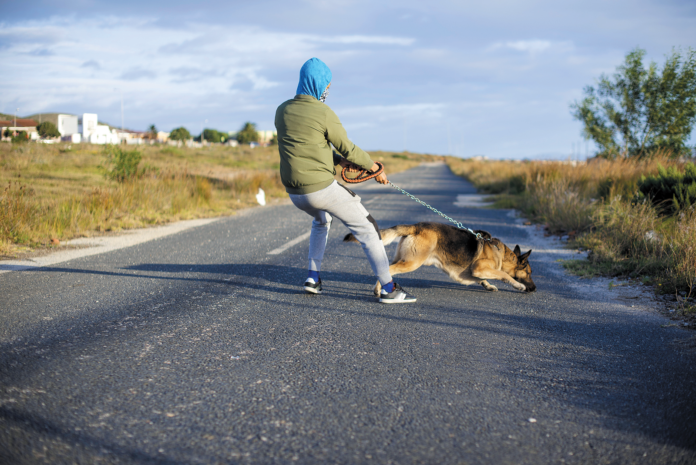Has your dog ever gone faster than you wanted, tugging vigorously enough on the leash that it’s annoying — or even a bit dangerous? Has he ever nudged you from behind to get you to pick up your pace?
Just as we like to train our dogs to do things when we want them to, they like to train us. And since they can’t use words, they often use their bodies, pulling and pushing us along at the rate that feels right to them.
Our instinct is to tell them we don’t like it by saying to “Stop it.” But “Stop it” and similar admonitions don’t have much meaning for dogs. They hear those phrases so often, and in so many different contexts, that they’re not words canines can learn to apply to a specific situation.
A better bet is to respond with our own bodies — never with physical punishment but simply by passively reacting to their action. Or, to put it another way, by not reacting. Here are a couple of scenarios.
Muzzle punching. A muzzle punch is a thrust of a dog’s face into the back of your leg, commonly in the back of your knee. “Punch” is a misnomer because the force of the push is more like a nudge. It’s a dog’s way of saying with affection that he loves you but that you should move it along. Common among herding dogs, it’s a habit many people could live without.
The best way to teach your dog not to do it: Stand still every single time he muzzle punches you. Don’t heed his cue, and don’t even keep moving at your own pace. He will soon learn that pushing you in the back of the knee has backfired because you have learned the wrong “trick.” You think it means “stop walking,” and he will leave off trying to get you to respond to it.
Tugging on the leash. Many dogs like to control the pace of walks outdoors. And it is important to give a dog time to sniff things he finds interesting even if the walk takes five or 10 minutes longer than you anticipated. But a lot of dogs want to go along at a speed that’s too fast for people to walk comfortably. They tug on the leash with their necks much of the time, and it makes the experience difficult.
Again, the solution is simply to stop in your tracks. You’re not being mean. You’re letting the dog know, “This is not working for me. Your pace is too fast for my comfort and safety, and you need to compromise.”
It will take the dog a little while to figure out that his training is not going to work on you, but he will get it soon enough, especially if you reward him with a treat for complying.
A lot of teaching goes like this. Often, the best reaction is not to respond to provocative behavior but to redirect towards acceptable behavior.






We have a rescue dog who barks nonstop every time we let her and our other dog out for potty. I’m sure she learned this behavior when she was with several other dogs in the house from which she was rescued. She barks until the door is open then barks and is play-aggressive with our other dog before then doing her business. I’ve tried not opening the door until she stops barking and ignoring her, but nothing I’ve tried works. I’m afraid this behavior is so ingrained that it can’t be modified. Any suggestions?
My dog (Min. Schnauzer) is very gentle one on one with me and family or unleashed at the dog park but lunges and barks at other dogs walking across the street (and even people who come too close) on leashed walks. Any ideas?
I learned a trick from the rescue organization where I just adopted a little senior dog who also barks a lot (just ask my neighbors). They called it the 1 2 3 game. You start by loudly saying 1, then 2, then on 3 you quickly put a treat in his mouth. Practice this in a non-stressful situation so that when he hears you start to count he knows there is a treat in the future. The treat needs to be immediately after the 3 is spoken. Don’t ask for a sit or any other behavior in between the 3 and the treat getting in his mouth. After practice he stops barking and pays attention to you on 1 – anticipating the treat. It works for Sammy. Hope you also find it helpful.